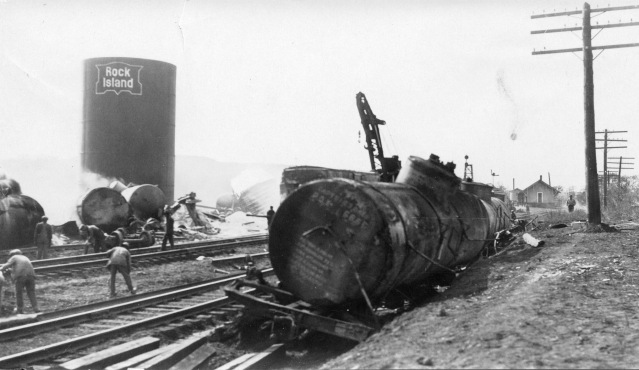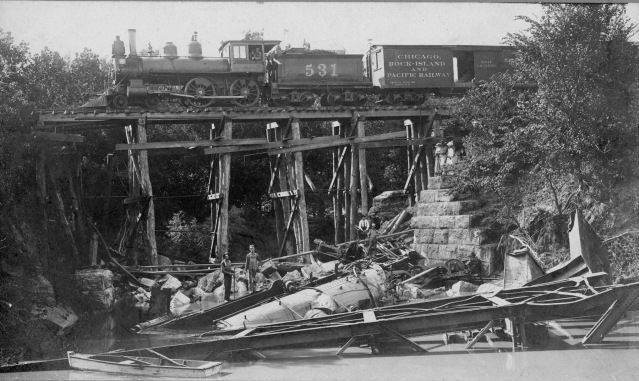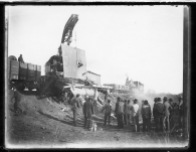In the history of Wabaunsee County, among the significant events which shaped the county’s development and growth were the coming of the railroad in 1880 and the subsequent addition of a second railroad seven years later. For a century the railroad provided transportation, commerce and employment for the citizens of Wabaunsee County.

Atchison, Topeka & Santa Fe tracks outside of Alma, Kansas show considerable damage after flooding in 1936.
When one considers the rail traffic in Wabaunsee County, particularly in the first half of the 20th century, it’s not a surprise that train wrecks were not an uncommon event in the county. The tracks of both railroads had been laid along the flat bottom-ground bordering Mill Creek, and they were prone to damage from flooding.

Burnt wreckage from a derailed train at Volland, Kansas was still smoking when Alma photographer Gus Meier photographed the wreck scene. A crowd of people appear to be attending someone in the grove of trees.
But, the biggest disaster in the history of Wabaunsee County, which occurred 110 years ago in the early morning hours of January 2, 1907, was not caused by a flood or natural disaster, but was a case of human error. Thirty-two passengers of two Rock Island Railway trains died and forty more riders injured when the eastbound No.30 crashed head-on with the westbound No. 29, just two miles west of the Volland station.

This Gus Meier photograph, circa 1898, shows the burnt wreckage of a train which derailed and crashed about a half mile west of Volland, Kansas
Sometime after midnight the No. 29 had been split into two west bound trains because of the heavy holiday traffic. The first No. 29 had passed through Volland on time; however, the second No. 29 was late. The late train was scheduled to meet the eastbound No.30 in Alta Vista, but since the 29 was late, the Topeka dispatcher ordered the two trains meeting point be changed to Volland. A call was placed to Volland to see if the No. 29 was in the station, which it was, as it was waiting for the eastbound No. 14 to pass on the single through track.

Railroad cars carrying fuel derailed and burned near the Volland depot in this view, dated 1920.
While the No. 14 was passing, the decision was made for the scheduled meet with the No. 30 to be moved to Volland, and the order was given to hold the No. 29. By the time this order was given, the No. 29 had backed onto the through track, and had begun its departure to the west. The Volland station operator, John Lyens, realizing that the No. 29 was not going to stop at the station, raced from the depot waving his lantern to attempt to stop the train, but the flame from the lantern was extinguished by the wind. His attempts to stop the No. 29 were in vain.

This photograph of the wreckage of tanker cars at Volland, Kansas was probably taken the day after the 1920 crash and fire. Notice the railroad wrecker working in the center of the photo. The Volland depot is visible in the background.
Lyens raced into the Western Union office of the depot, sending a message to Topeka, “No. 29 has gone and I have gone also.” As there was no communication with the trains on the track, the impending disaster could not be stopped. The two trains collided head-on about two miles west of Volland on a sharp curve. When the Engineer and Fireman on the No. 29 saw the oncoming No. 30, they applied the emergency brakes, reversed their engine, and at the last second, leapt from the locomotive. The crew of the No. 30 jumped from their locomotive before impact, as well.

A small crowd of people inspect the wreck of a Rock Island locomotive at Maple Hill, Kansas in this photo dated November 12, 1900.
The collision occurred at 4:50 am. Despite the fact that the No. 29 was almost stopped by the time of impact, the No. 30 was going downgrade, and the damage inflicted upon the 29 was enormous. A smoker car on the No. 29 was filled with Mexican railroad workers who had been given rail passes to go home to El Paso for the holiday season. Reportedly, as many as 70 Mexican Nationals were aboard the No. 29. When the trains collided, many passengers were pinned in the wreckage, and within minutes the entire wreck scene was engulfed in flames. It was reported in the newspapers to be a most gruesome scene with badly injured passengers trapped in the fiery wreckage.

Flood waters from the 1903 flood undermined the railroad bridge in the foreground, causing it to collapse under the weight of a passing locomotive. Remains of the boiler remain in the creek today. A second CRIP locomotive is stopped on a trestle to the west, surveying the scene.
The Wabaunsee County Coroner, Dr. George W. B. Beverly’s report on the accident stated that 32 individuals were killed in the accident, including 27 Mexican railroad laborers. Three of the bodies of Mexican workers were never recovered, but 24 victims were buried in a mass grave in the Catholic Church cemetery in Alma. A coroner’s inquest was held at the Wabaunsee County Courthouse on January 14, 1907, and the inquest jury concluded that Volland Operator, John Lyens and Topeka Dispatcher, J. H. Shumate were both responsible for the accident, but the railroad did not hold them criminally liable. Dr. Beverley was reportedly so affected by the carnage of the crash scene that he resigned his position as County Corner shortly after the completion of the inquest.

This photograph of a derailed boxcar containing new automobiles was taken by Alma, Kansas resident, Arthur Vobach. Photo Courtesy Jay Dee Miller.
In a most interesting twist, the locomotive which was pulling the ill-fated No. 29 was locomotive No. 1334, an engine with a history of bad luck. The very same locomotive was pulling a Rock Island passenger train through Willard, Kansas in January of 1904 when it wrecked, killing twenty people. Locomotive 1334 had also been in three additional wrecks which had not resulted in losses of life.

Five men pose in front of the wreckage of Locomotive 1334 which was pulling the Rock Island No. 29 westbound train when it struck the No. 30 eastbound, head-on.
To view the photos below in a gallery format or full-screen, click on any image below.


Categories: Museum Blog, Photographs, Rock Island Railway

























Very Good Tom, thanks for remembering an Old man. As Wayne Grindol had posted on his E-mail “Old age is not for Sissies” so True
LikeLike
” A case of human error.” Sadly, we all make mistakes. Thankfully, we can always improve by thinking more logically and acting more ethically every day. Logic: If a train is late, then get “back onto the track.” Ethics: John wanted to help by “waving his lantern to attempt to stop the train.”
LikeLike
Why was Volland selected as siding.?.?.? Why not Alma.?.?.? Why not Alta Vista.?.?.? Once you start East from White City, it’s all downgrade to the river…
What was the reason Volland was used.?.?.?
LikeLike
Hello,
I’m wondering if you have any information on passenger train No. 224 – Rock Island Passenger train – that derailed near Clay Center, Kansas. It had left from Omaha. Not sure the date of the derailment – I’m guessing late 1920s. Thank you!
LikeLike
September 27, 1929 was the date. Rocky Mountain Limited #8 was going from Colorado to Omaha and Chicago and would stop at Belleville to let passengers board #224 bound for Kansas City.. This accident is believed to have been caused by uneven track. See ICC Accident Report 1565.
LikeLike